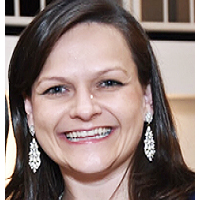Recurrent Peripheral Ameloblastoma of the Mandible: A Case Report
Published on: 30th January, 2017
OCLC Number/Unique Identifier: 7286357027
Ameloblastoma is the second most common odontogenic tumor being back only for the odontoma. An unusual case of recurrent peripheral ameloblastoma in the mandible from the site of previous occurrence, reducing oropharyngeal space due compression by lesion. Panoramic radiography not showed presence of lesion, except one step in left side of mandible angle. Multislice CT scans revealed presence of hypoattenuated image, well-defined, histopathological exam suggesting Ameloblastoma Follicular.
Tumours of the Uterine Corpus: A Histopathological and Prognostic Evaluation Preliminary of 429 Patients
Published on: 30th January, 2017
OCLC Number/Unique Identifier: 7286353787
A histopathological review preliminary of 429 patients diagnosed with tumours of the uterine corpus (TUC) cancer between 1984- 2010 in the Vigo University Hospital Complex (Spain) were evaluated prospectively for over 5 years. Of these 403 (93.9%) were epithelial tumours: 355 (82.7%) were adenocarcinomas of the endometrioid type, 5 (1.1%) mucinous adenocarcinoma, 10 (2.3%) serous adenocarcinoma, 17 (3.9%) clear cell carcinomas, 11 (2.5%) mixed adenocarcinoma, 4 (0.9%) undifferentiated carcinomas and 1 (0.2%) squamous cell carcinomas. A total 20 (4, 6%) were mesenchymal tumours: 4 (0.9%) endometrial stromal sarcoma, 7 (1.6%) Leiomyosarcoma, 9 (2%) Mixed endometrial stromal and smooth muscle tumour. A total 1 (0.2%) were mixed epithelial and mesenchymal tumours: (0.2%) Adenosarcoma 1. And 5 (1.1%) were Metastases from extragenital primary tumour (3 carcinomas of the breast, 1 stomach and 1 colon). The mean age at diagnosis from total series were 65, 4 years (range 28-101 years). Age was clearly related to histologic type: Endometrial stromal sarcoma 46.0 years, Leiomyosarcomas 57.1 years, Adenocarcinomas of the endometrioid type 65.4 years, Clear cell carcinomas 70.1 years and mixed endometrial stromal and smooth muscle tumours 71.2 years. Five-year disease-free survival rates for the entire group were: Endometrial stromal sarcoma 50%, Leiomyosarcomas 28.6%, Adenocarcinomas of the endometrioid type 83.7%, Clear cell carcinomas 64.7% and mixed endometrial stromal and smooth muscle tumours 44.4%. The 5-year disease-free survival rates of patients with Adenocarcinomas of the endometrioid type tumors were 91.4% for grade 1 tumors, 77.5% for grade 2, and 72.7% for grade 3.
In conclusion, we describe 5-year histological and disease-free survival data from a series of 429 patients with TUC, observing similar percentages to those described in the medical literature. The only difference we find with other published series is a slightly lower percentage of serous carcinomas (ESC) that the Western countries but similar to the 3% of all ESC in Japan. Our investigation is focus at the moment on construct genealogical trees for the possible identification of hereditary syndromes and to carry out germline mutation analysis.
Cystic fibrosis, the key link with airborne alpha emitting nanoparticulates
Published on: 18th June, 2021
OCLC Number/Unique Identifier: 9100376557
Cystic fibrosis is explained in this paper that suggests tackling the disease by elimination of the most significant sources of contamination.
Toxicity and Phytochemical Analysis of Five Medicinal Plants
Published on: 25th April, 2024
Recent studies have shown that long-term uses of herbs have been associated with a rise in morbidity and mortality rates. While most researches are focused on bioactivity investigations, the toxicity of many plants has not been reported. There is a paucity of data on the potential toxicity of the following plants: Harungana madagascariensis (HM), Pterocarpus osun (PO), Phoenix dactylifera (PD), Annona muricata (AM), and Rutidea parviflora (RP). To evaluate the toxicity of the above-mentioned plants; two tests were employed namely: The Brine shrimp lethality test (BSLT) and the Allium cepa test. A correlation between the oral acute toxicity assay in mice and the LC50 obtained from BSLT has been established. Allium cepa test measures the potential genotoxic effects of plant extracts exerted on the root meristem of A. cepa (onions). Plant extracts were administered in concentrations ranging from 100 to 2500 µg/ml to the A. cepa for 72 h to obtain their Mitotic Indices (MI) and EC50. Results of the MI at 2500 µg/ml for HM, PO, PD, AM, and RP were 3.75, 4.96, 5.96, 6.10, and 6.71 while 281.81, 398.11, 501.19, 630.96, and 707.9 µg/ml were obtained as the respective EC50 values. Furthermore, 10-1000 mcg/ml concentrations were administered in the BSLT and the obtained LC50 values were 116.3, 250, 581.5, 581.5, and 750 µg/ml. The toxicity result demonstrated that the five plants were moderately toxic, with RP exhibiting minimal toxicity values and thus potentially having a good safety profile. The phytochemical screening of these plants revealed the presence of some pharmacologically important classes of compounds that are abundant. Several bioactive and toxic compounds were identified in the GC-MS analysis for some of the plants.
A Critical Review on Some Recent Developments in Comparison of Biological Sequences
Published on: 25th April, 2024
The present review highlights some of the very important contributions to non-alignment ways of comparing biological sequences, which may be genome sequences of nucleotides, protein sequences of amino acids, or sequences of protein secondary structures. The discussion centers around specific methods applicable to the comparison of three types of sequences. The methods of comparison of genome sequences are based on three pairs of biological groups of nucleotides; the same for protein sequences are based on either physio-chemical property values of amino acids or on classified groups of amino acids of different cardinalities obtained from the physio-chemical properties; the same for sequences of secondary structures of proteins are based on their sequential expressions of structure elements of cardinality three and four. Comparison is made in the time domain and also in the frequency domain. Different taxa of known phylogeny are considered for comparison. It tries to find out the specific method of comparison, which can show the exact phylogeny of the taxa. If a new sequence appears in the database, it becomes essential to know its phylogeny. For this purpose, a phylogenetic tree is drawn on the sequences of the known taxa together with this new sequence using the best possible method. If the species having this new sequence belongs to the old taxa, there is nothing to worry about. Otherwise, the species with the new sequence has to be studied separately. This is the general reason for the construction of a phylogenetic tree in any form of biological sequence comparison.
A few observations of clinical importance
Published on: 4th June, 2019
OCLC Number/Unique Identifier: 8165450552
This article reflects the opinion on a few of my clinical experiences involving symptoms and signs which are not mentioned in standard textbooks on medicine or clinical methods. These are clinical and a few radiological signs which I think worth discussing by clinical community, includes Muslim prayer’s feet, hyponatraemic bullae, early signs of oedema, PCV sign, hemi-semi-Hoffman’s sign and a few more.
Occipital lobe ependymal cyst with unusual presentation
Published on: 19th September, 2019
OCLC Number/Unique Identifier: 8286553600
Intraparenchymal cysts without communication to the ventricles or the subarachnoid space are named ependymal or epithelial cysts. The estimated ratio of their incidence compared with arachnoid cysts is 1:10. Neurologic deficit can occur when the cyst exerts mass effect on its surroundings. We report a case of cerebral ependymal cyst in a 75-year-old lady who presented with history of headache, vomiting and left incomplete homonymous hemianopsia. Neuroimaging studies showed a large right occipital cyst. She underwent the neurosurgical procedure of marsupialization. Histologic findings and the immunophenotype was consistent with a diagnosis of ependymal cyst. The patient made an excellent recovery after the procedure.
An uncommon cause of isolated ascites: Pseudomyxoma peritonei
Published on: 26th April, 2019
OCLC Number/Unique Identifier: 8163913595
Pseudomyxoma peritonei (PMP) or Gelatinous Peritoneal Disease is a rare condition that refers to an anatomo-clinical entity characterized by ascites of variable abundance in the peritoneal cavity, viscous or mucinous, associated or not with neoplastic epithelial cells. It predominates in women. Diagnosis is guided by imaging and confirmed by histology. Prognosis is good in case of early management. We report the case of a male diagnosed with Pseudomyxoma peritonei revealed by isolated ascites.
Changes in Private Psychiatric Outservice Related to SARS-CoV-2 Pandemic
Published on: 8th November, 2024
The SARS-CoV-2 pandemic, which began in late 2019, initially manifested with acute respiratory symptoms, including bilateral pneumonia, and later emerged as a systemic disease. This brief report assesses changes in the clinical profiles of psychiatric outpatients before, during, and after the pandemic’s most severe periods, focusing on mood, anxiety, and cognitive symptoms. Data from a private psychiatric facility in Rome reveal that both pandemic-related stressors and SARS-CoV-2 infection itself may contribute to enduring affective and cognitive symptoms in both older and younger adult subgroups. Notably, during the pandemic, older patients showed elevated psychopathology scores (BPRS-24) compared to younger individuals. In the post-pandemic period, younger adults exhibited increased positive symptoms on the PANSS Positive subscale, suggesting a gradual worsening in symptoms post-pandemic ( = 0.47). Cognitive assessments (MMSE and PM38) further highlighted fluctuating performance over time, with older adults showing two distinct declines during the pandemic and in 2024. This work underscores the importance of sustained mental health interventions to address the pandemic’s psychosocial and neuroinflammatory legacy. This perspective also considers new data on the CNS effects of “toxin-like peptides” synthesized by microbiome bacteria.
Transcatheter Arterial Embolization for the treatment of upper gastrointestinal bleeding
Published on: 7th June, 2019
OCLC Number/Unique Identifier: 8165598100
Background: Transcatheter arterial embolization can be used for patients with recurrent bleeding from the upper gastrointestinal tract after failed endoscopic treatment. Our aim to identify the clinical and technical factors that influenced the outcome of transcatheter embolization for therapy of upper gastrointestinal bleeding after failed surgery or after failed endoscopic treatment in high risk surgical patients.
Methods: We performed a prospective study to analysis of the 15 patients who underwent Transcatheter arterial embolization for nonvariceal upper gastrointestinal bleeding at Alshifa hospital from January 2015 to March 2019.
The following variables were recorded: demographic data, time from bleeding start to TAE, units of packed red cells before TAE and units of packed plasma before Transcatheter arterial embolization and we analysis 30 days rebleeding rates and mortality.
Results: Patients treated with Transcatheter arterial embolization (median age: 62 years, range: 14–79 years).The technical success rate of the embolization procedure was 100%. Time from bleeding start to TAE was 2.1 (1-4) days , units of packed red cells before Transcatheter arterial embolization was 12.8 (4-22) packed and units of packed plasma was 3.2 (2-5) packed. Following 30 days after embolization, 2 (13%) patients had repeated bleeding and 3 (20.0%) patients died.
Conclusion: In our experience, arterial embolization is a safe and effective treatment method for upper gastrointestinal bleeding and a possible alternative to surgery for high-risk patients.




